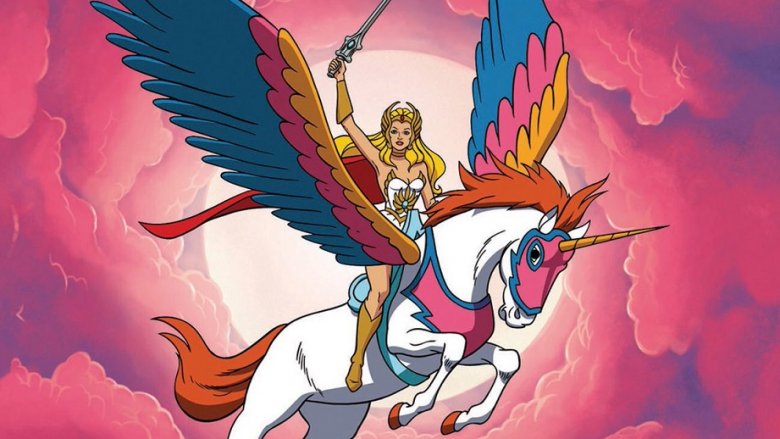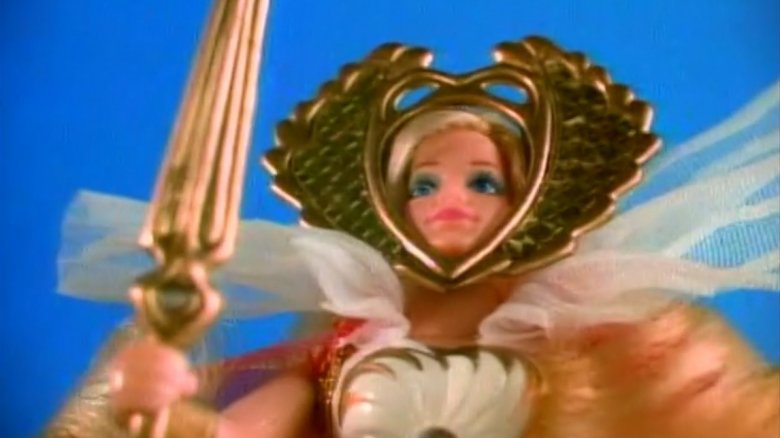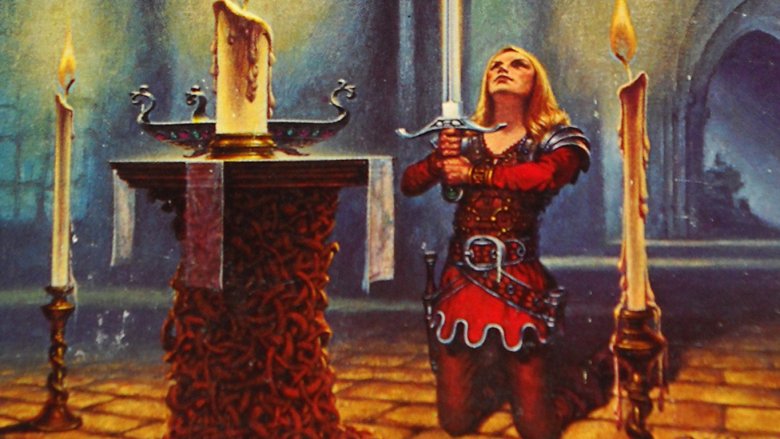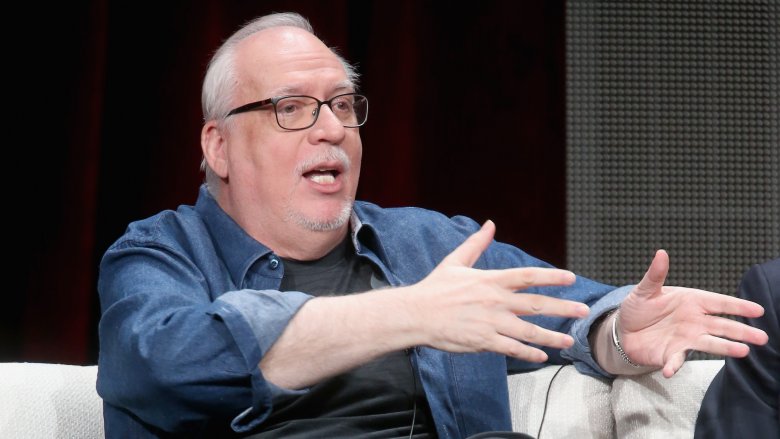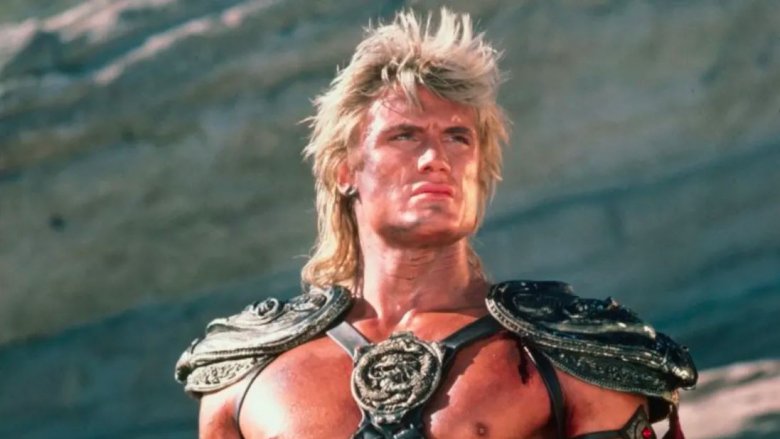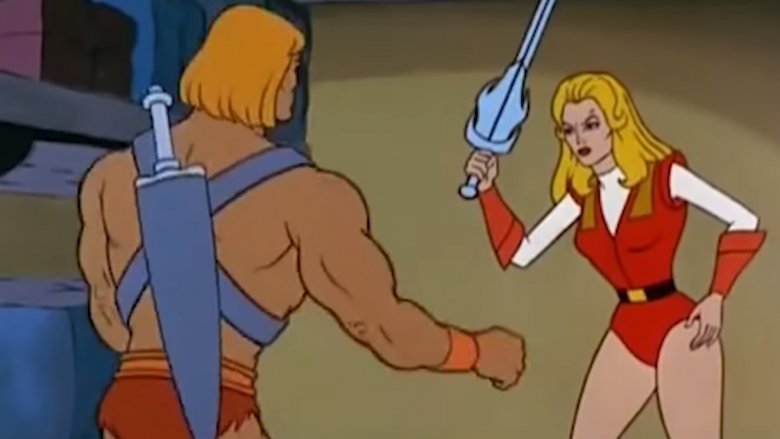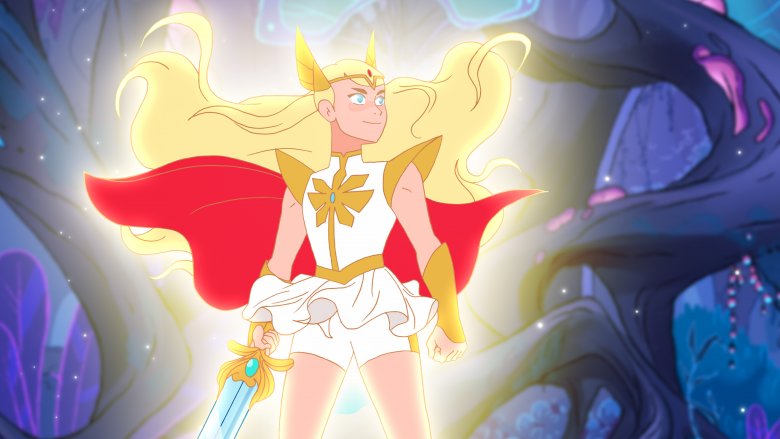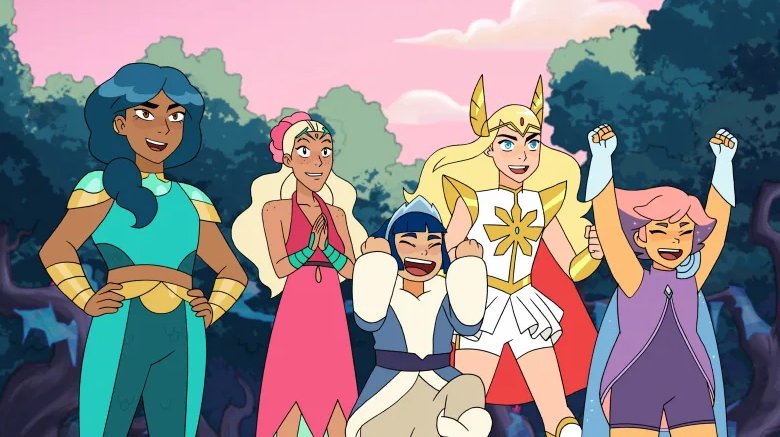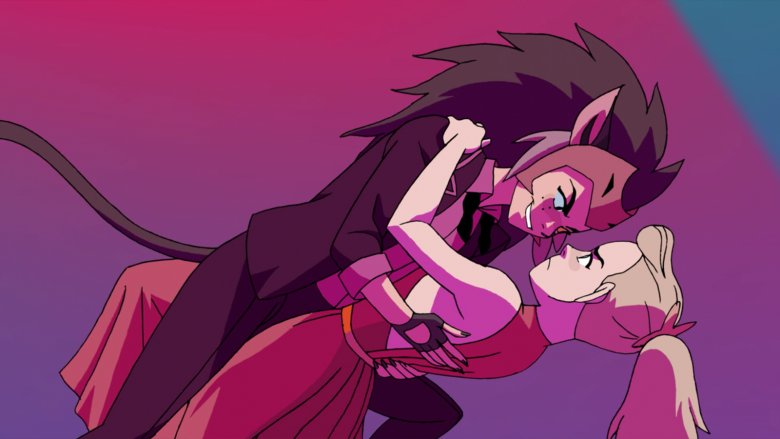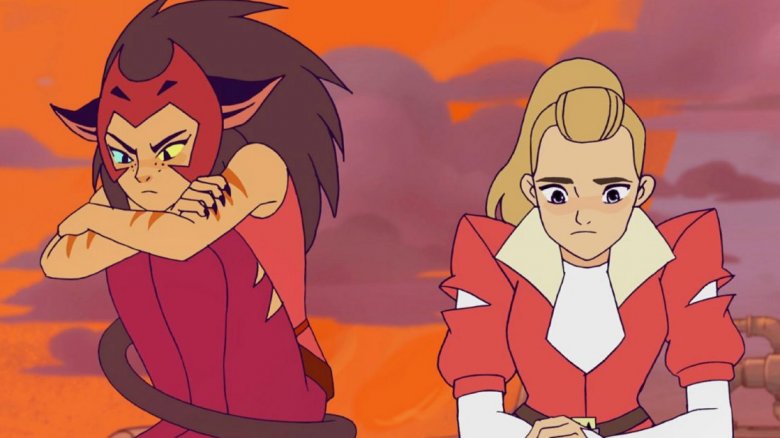The Untold Truth Of She-Ra
We may receive a commission on purchases made from links.
Since her debut in 1985, She-Ra has been a character who's defied categorization. The equal parts beautiful and badass twin sister of He-Man, she was originally created by Mattel as a way to sell more action figures to girls. Because of this, when her toys first arrived in stores, retailers didn't know where to stock them. Should they go with the other Masters of the Universe toys in the boy section or alongside the Barbie dolls in the girl section? The strict gender binary of the toy store's floor plan was not built to accommodate a woman with a sword!
Now, decades after we thought that She-Ra was gone for good, the Princess of Power is having a resurgence. With her rebooted Netflix series currently in its third season, She-Ra is arguably even outshining her typically top billed twin brother in the cultural zeitgeist.
From her origins as a spin-off character to her recent re-introduction to a new generation, we bring you a mix of strange tales from behind-the-scenes of the She-Ra cartoons, along with a few stories about how this unconventional character first impacted our culture and continues to do so today. So for kids of all ages and genders who don't want to choose between blowing up robots and having perfect hair while doing it, this is for you. This is the untold truth of She-Ra.
She-Ra's tiara was originally supposed to be a mask
The first She-Ra figure that was released in early 1985 looked a little different than you might expect. Her tiara, if it could even be called that, was an enormous monstrosity that wrapped all around her face like a lion's mane. The reason for this is that her crown was designed to serve a dual function. When Princess Adora transformed into She-Ra, her tiara could be turned upside down, at which point it would become a golden superhero mask.
In the first few She-Ra comics that were released, which predate her debut as a cartoon character, she's illustrated with this golden mask while in her superhero identity, and with a similar face-framing crown while as Adora.
It was certainly a cool idea, but it didn't work in the execution. First of all, during testing, most kids didn't want to cover She-Ra's face when they were playing with her, so this dual functionality of the crown was rarely used. Also, it was just plain weird looking. Because of this, even in the earliest comics, the illustrations scale the tiara down and alter the shape of it a bit to make it look a little less ridiculous.
When She-Ra finally made her cartoon debut that year, the whole reversible crown thing was dropped, and later toys and comics followed suit. Ever since, She-Ra has sported her now iconic tiara which does one thing well, rather than doing two things poorly.
Mattel bought the rights to another 'Sheera'
A largely unknown footnote in early She-Ra history was brought to light by the 2012 documentary Toy Masters, which investigates the surprisingly tangled and nebulous question of who invented the character of He-Man. Along the way, the documentary explores other side stories and ethical questions related to ownership of characters that are made by large teams of creators.
The film reveals that around the time that She-Ra was coming out, Mattel paid $25,000 to author Barbara Hambly for the ancillary rights to a series of novels she wrote called Sun Wolf and Starhawk. We don't know for certain why they did this, but if we had to guess, it's probably because the main character in the first novel of that series, The Ladies of Mandrigyn, is named "Sheera." If another toy company were to buy the rights to make merchandise for that series, they would be legally allowed to make "Sheera" toys of their own to compete with Mattel's line.
It seems like, during her interactions with Mattel, Hambly made a good impression, because the ending to this strange story is that Hambly eventually ended up getting hired to write an episode of the She-Ra cartoon called Above It All. Maybe while someone at Mattel was reading through her books in order to determine the likelihood of future legal troubles, they ended up becoming a fan of her work and offered her a job.
There were some great writers on the original show
Besides just Barbara Hambly, much of the rest of She-Ra: Princess of Power's writing staff also went on to have great careers after the series ended. Writer Larry DiTillio, who penned 18 episodes of the original She-Ra, went on to become the executive story editor of Babylon 5. However, he continued to work in cartoons all throughout his life. Among his many accomplishments in children's animation is the fact that he wrote or co-wrote most episodes of the TV show Beast Wars.
Another She-Ra writer who went on to become a star was J. Michael Straczynski (pictured above), a highly prolific writer who contributed to many popular TV shows, from Walker, Texas Ranger and Murder, She Wrote to Sense8. He also wrote the movie Changeling, and has "story by" credits on World War Z and Thor.
Perhaps the most unexpected breakout stars of She-Ra were the music composers for all 93 episodes, Haim Saban and Shuki Levy, who in a few years would go on to create their own She-Ra-sized pop culture phenomenon in the form of Power Rangers.
She-Ra almost made the leap into live action
In 1986, He-Man was on top of the world. A big budget Hollywood movie — or at least, a medium budget one — was more or less inevitable. Less certain, however, was the question of whether or not He-Man's sister would be joining him for his trip into live action.
Several people involved with the Masters of the Universe film, such as production designer William Stout, have confirmed that She-Ra was indeed included in a few early drafts of the script, but in the end, the filmmakers decided to focus the first movie solely on the exploits of Prince Adam and to save Adora for the sequel.
Unfortunately for She-Ra and her fans around the world, that sequel never came to pass, because when the Masters of the Universe film finally came out in 1987, it was a complete and total failure, only making $17 million against a budget of $22 million dollars. Perhaps it was because the film hit a year too late, when the He-Man fad was already essentially over, or perhaps it was because the film was just plain bad, as it currently holds a measly 17 percent on Rotten Tomatoes. Regardless, we sadly never got to see what a live action She-Ra would look like. We do have, however, some early concept art for the film, which includes a potential design for She-Ra's cinematic outfit. It's totally different from her look in the cartoon, but we think you'll agree with us that it's pretty darn cool.
She-Ra was blamed for killing He-Man
Although He-Man and She-Ra toys sales were steadily climbing each year since their initial release in 1982, peaking at $400 million in 1986, they suddenly crashed in 1987, down to only $7 million. Dave Capper, director of marketing for boys' toys at Mattel, felt that She-Ra was to blame. In the Netflix documentary series The Toys That Made Us, Capper said, "We started to get feedback that if an eight-year-old boy had been playing with He-Man for two or three years, and now his sister was saying, 'I have the power,' that there was something that just didn't feel as cool."
Janice Varney-Hamlin, former director of worldwide marketing for fashion dolls at Mattel, had a response to Capper, that his theory was "the most ridiculous thing I had ever heard of."
Mark Ellis, former Mattel VP, offered an alternate take, that the once-strong quality of the toy line had become diluted with too many uninteresting side characters, saying, "We ended up ... having a disproportionate mix of tertiary characters on the shelves, and none of the He-Man and Skeletors. ... So the new kids coming in couldn't start the collection appropriately, and that's in fact what led to large inventories and then the overall product going down."
Maybe the overabundance of unwanted toys was to blame, maybe He-Man was just a fad that was always destined to die, but it seems like regardless of why kids eventually moved on to the next thing, She-Ra probably had little to do with it.
Her reboot costume made the internet explode
Out of all the non-issue "controversies" to bring the weirdest hot takes out of the strange dark corners of the internet, perhaps none is more infamous than kerfuffle that occurred after the reveal of She-Ra's redesign from the 2018 reboot.
In her new design, She-Ra eschews makeup and her previous pin-up model proportions in favor of looking more like a realistic, athletic teenager. Her outfit now also has tiny shorts under her skirt, probably because trying to draw a character doing action poses while wearing a skirt without showing any underwear was a constant struggle in the original show.
However, certain He-Manbabies took this new design as a personal offense, and decided to engage in a little performative hair pulling, with angry Twitter users saying that she didn't look like a girl anymore. Fortunately, the backlash against this backlash was even stronger. Even J. Michael Straczynski, co-creator of the original cartoon, weighed in, saying that he and his co-creator, Larry DiTillio, "spoke, and wrote of, and considered her a warrior, first and foremost. ... If you're looking for writers to create your 'ideal woman,' that wasn't the intent ... and be aware that idealization does not equal objectification."
She-Ra's new series is a hit
After all the hype, the speculation, and even "Costumegate," it turns out no childhoods were ruined when the new series actually premiered, because She-Ra and the Princesses of Power is rock solid. The first season currently boasts a 100 percent approval rating on Rotten Tomatoes, and later seasons aren't that far behind.
The new show is generally loved for many reasons, first and foremost of which is that the writing is exemplary. Adora's struggles to recover from the abuse she suffered while being raised by the Horde mirror the real-life struggles of teenagers who grow up in abusive households, and all the other characters gain similar levels of three-dimensionality. Even the typically bad to the bone Hordak has some surprisingly moments of vulnerability.
The "most improved" award definitely goes to Catra, who's gone from being just one of Hordak's many forgettable lackeys to now basically the second most important character in the show, a tragic anti-villain in the vein of Magneto or Kylo Ren. Although to be fair, this elevation of Catra could be considered a throwback, since in the earliest She-Ra stories — those original promotional mini-comics where She-Ra had the awful headdress — Catra was the main villain, and there was no Hordak at all.
Also, the supporting heroes have been diversified quite a bit in numerous ways. They were pretty much all bland Caucasian Barbie dolls in different outfits in the original, but now they have a much wider array of personalities, races, and body types.
The new show is wonderfully, triumphantly queer
Among the many reasons that the new She-Ra reboot has been critically acclaimed is because it contains a few instances of positive LGBTQ+ representation, a rarity in children's entertainment. Towards the end of the first season, we briefly meet Spinnerella and Netossa, two minor princesses who are implied to be in a relationship. In season two, it was revealed that Bo, one of the central characters of the show, has two dads. Also, if you want to get really tin-foil hatty, there's even some evidence that this version of Bo might be a trans man. It was enough that the series was nominated for "Outstanding Kids & Family Programming" at the 30th annual GLAAD Media Awards.
One reason for all this queer content might be because the series creator, Noelle Stevenson, is a queer woman herself, so if you want to know who's responsible for all this unprecedented representation, it probably started with her. One example of her playfully brazen attitude towards queer inclusivity can be heard during an interview on an episode of the podcast She-Ra: Progressive of Power. Stevenson was asked about the presence of a rainbow in the season one finale and whether or not it symbolized something. Stevenson simply responded, "The gay agenda."
But is the show queer enough?
Despite these strides, some LGBTQ+ viewers are still disappointed with the new She-Ra series, as its only only confirmed queer characters are minor ones. Far more frequently, the show implies the potential for queer content, but doesn't deliver on it. For instance, despite the heaping helping of romantic subtext between Adora and Catra, their relationship is only ever referred to as a "friendship."
This phenomenon, placing ambiguously queer content in the subtext without ever letting it rise to the level of text, is sometimes known as "queerbaiting." It's generally done to hook LGBTQ+ viewers without alienating homophobic ones. Xena: Warrior Princess was infamous for this, and more recent examples of shows accused of queerbaiting include Sherlock and Killing Eve.
Perhaps this is why, despite being nominated, She-Ra lost its GLAAD award to Steven Universe, which has many unambiguously queer characters throughout its core cast. Then again, getting LGBTQ+ content into Steven Universe was a long and difficult battle for that show's creator. It's unfortunate for those of us who want more LGBTQ+ representation in our media, but it's not surprising. Despite how inspiring of a character She-Ra has been to many people for all sorts of reasons, never forget that She-Ra was created to be, and remains to this day, a product.
